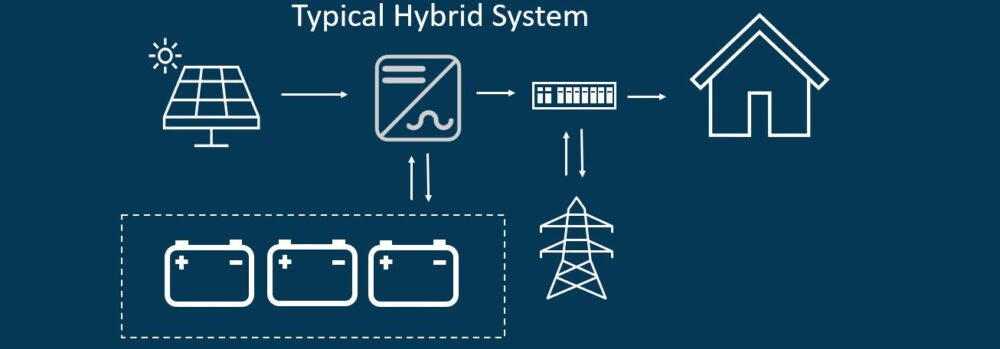Types of systems
There are a number of factors to take into account including feed in tariff’s, time of use and system size. Most importantly, over and above all these, is when you use the power. Is it mostly in real time and your not concerned with feed in tariff’s? Is it for storing in batteries and using at night? Is it both?

A simple grid tied system is the easiest way to get into the solar market and start saving straightaway. The products used are near commodities these days and can be purchased locally and affordably.
During the day when the sun is out, the panels will create DC electricity, this travels through a cable (Conductor) to the inverter where it is converted to AC electricity, what our appliances use. The appliances will use the power directly from the solar in the first instance, if more power is required, then it is imported from the grid and standard tariff rates. If the solar is producing more than what the combined appliances are, then the excess will export the excess back to the grid and retailers will pay a minimum for it.
TIP:
If you decide this is the best way to go, aim to use appliances like dishwashers, washing machines, dryers etc. during the day, it is better to save $0.26/kWh than to sell it and make $0.06/kWh

Ok, lets start with the word ‘hybrid’, the correct wording is Multi-mode, ‘hybrid’ is a word that has been widely adopted however – incorrect. The alternative wording used is also ‘Battery Ready’ also incorrect.
A multimode inverter adds another dimension to a domestic, industrial or commercial solar system. A multimode inverter allows consumers to add battery storage to their solar system.
The Breakdown
As with a grid tied solar system, the appliances will use power directly from the solar. If the load is more than what the solar is producing, the additional power requirement will come from either the battery or the grid, depending on how you want the system set up.
If the solar system is creating more power than required, the excess will first be used to charge the batteries, once the batteries are fully charged, then the excess will be fed back to the grid.
Once the sun goes down, the load be will powered by the batteries until they reach a low SOC (State of Charge) and then the load source will switch back to the grid.

Once again, there are a number of variations on the terminology for off-grid systems, SAPS (Stand-alone Power Systems), RAPS (Remote Area Power Sytems),
There are a number of theories on which methods below is best, AC coupled or DC coupled. Each have their advantages and disadvantages. Converting energy from AC to DC to AC implicates efficiency losses, to determine which type of system suits the application, it is imperative to understand the load profile. If more power is used during the day, AC coupled is the way to go, if more is used at night, then DC coupled is clearly a better option.
AC Coupled solutions have become more popular given that the installation is simpler, an AC inverter allows for longer strings of solar panels in the array, where an MPPT generally has a lower Voltage input and therefor requires multiple strings and often string fusing, a much more complicated installation.

Having 20 years experience is the Solar Industry, I am often asked what is the best structure for an off grid solar system. Let me start with saying that there is no one solution fits all – don’t be fooled. There are a number of factors that need to be included when considering which are the best products and what is the best solution for your needs.
Both AC coupled and DC coupled solutions have their advantages and disadvantages, but why do we need to stick to one or the other, the most reliable solution, is always a combination of both, the AC inverter gives efficiencies during the day where the DC coupled MPPT ensures the battery is receiving charge during the day, even when the load exceeds the production!



